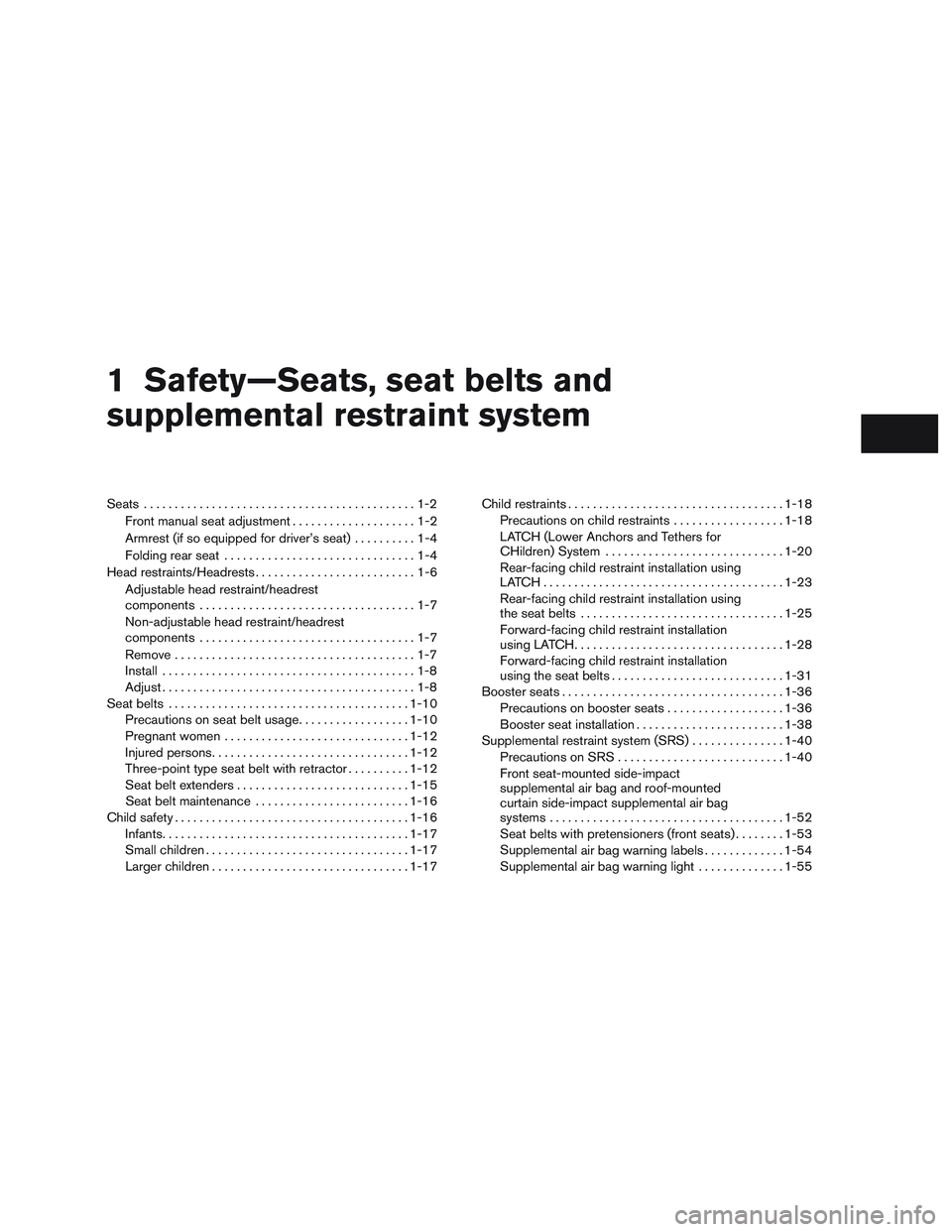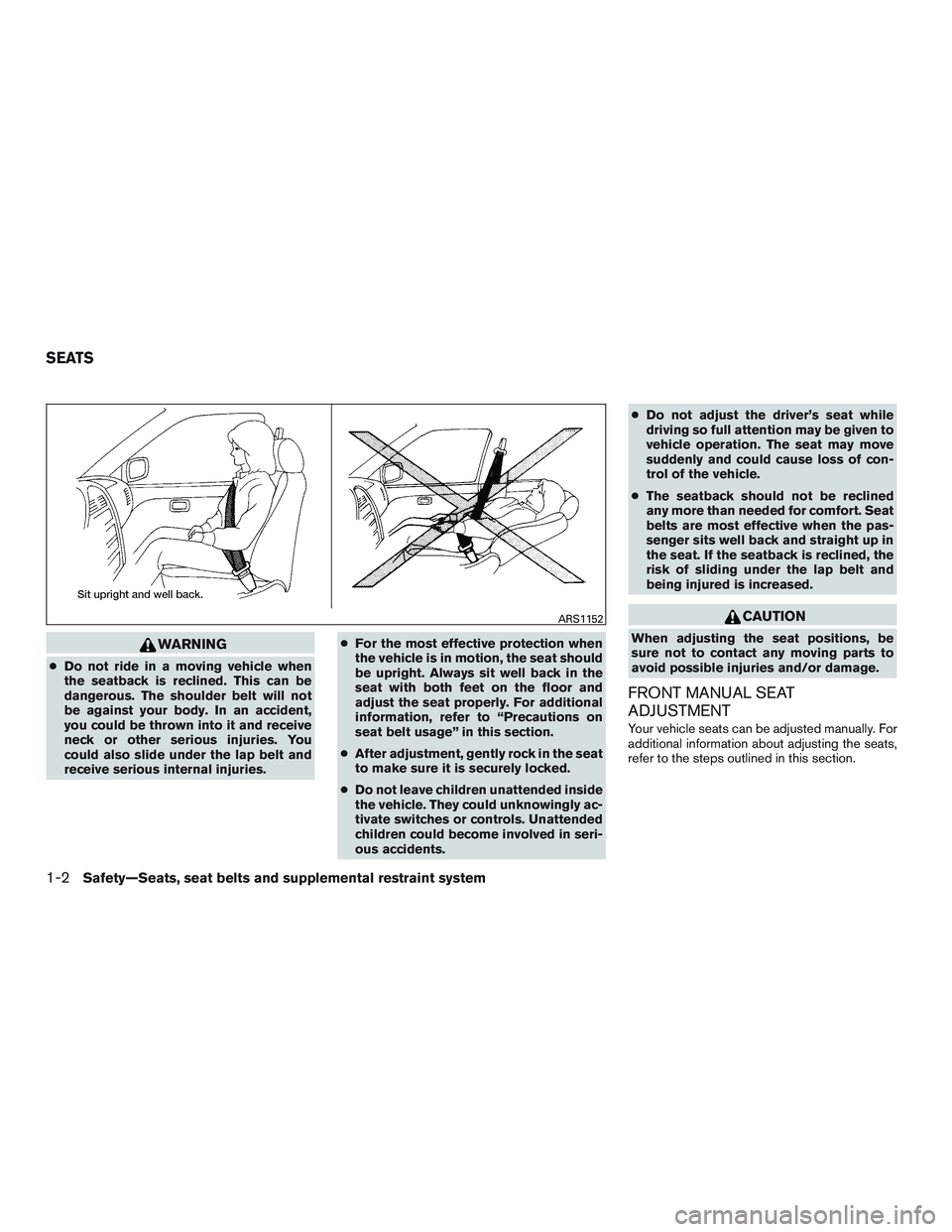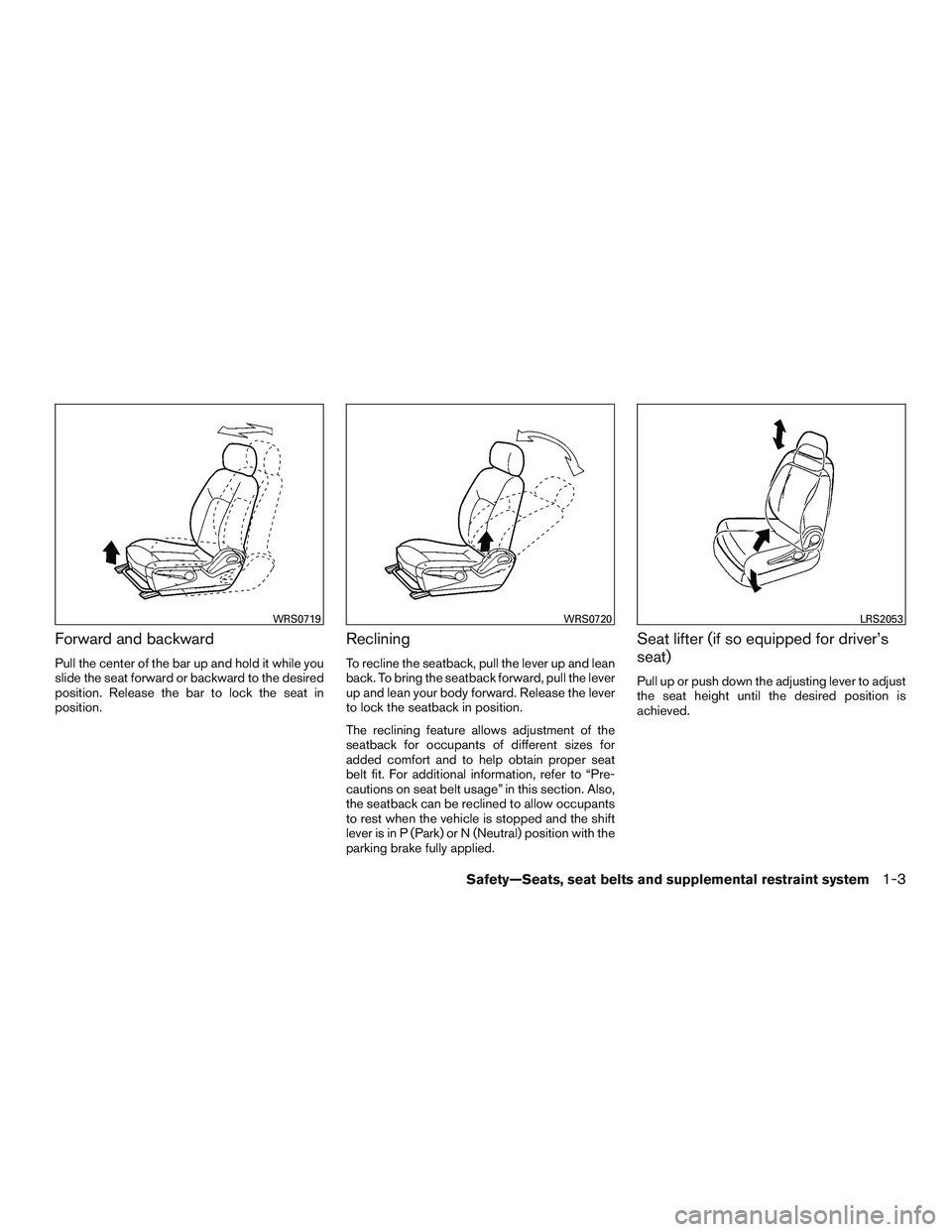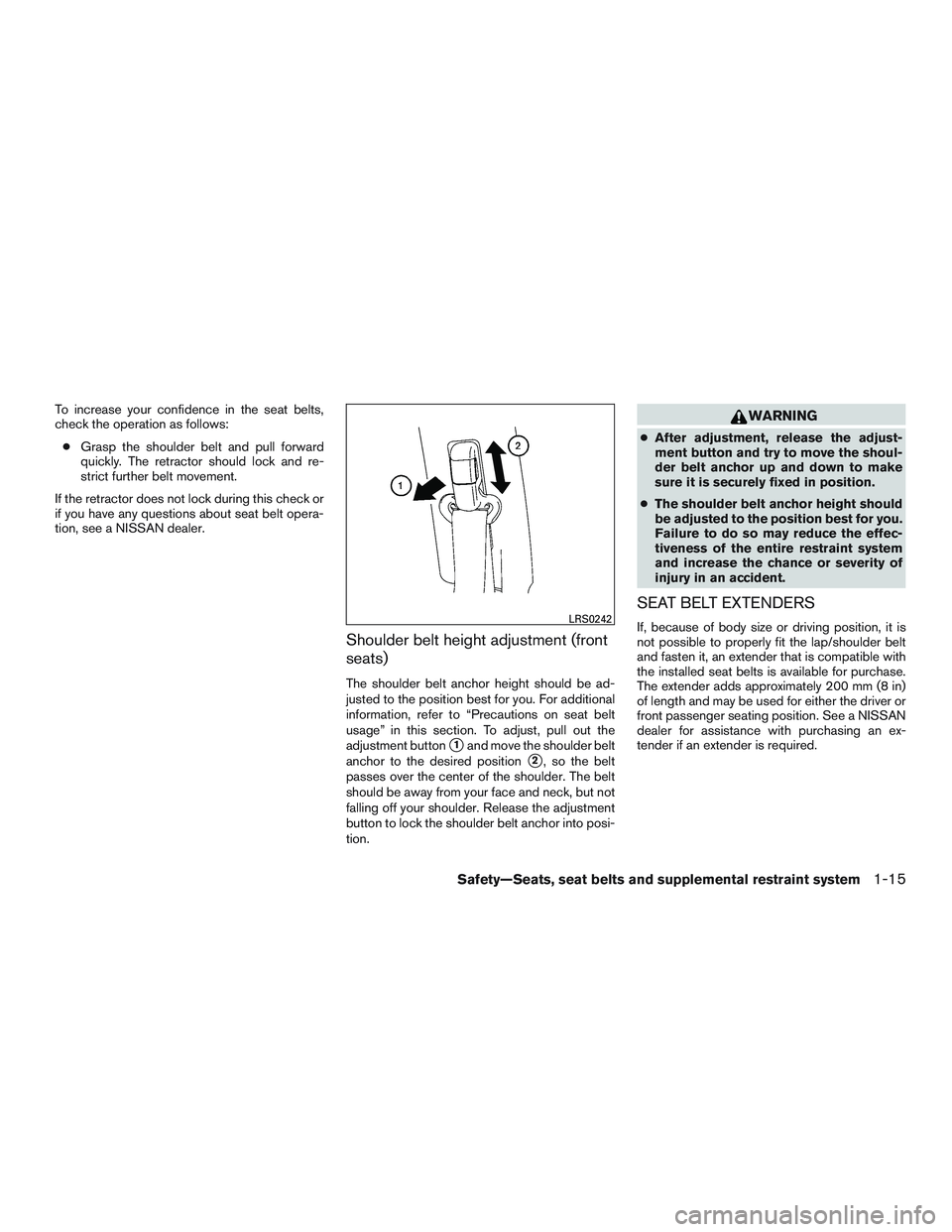Page 18 of 293

1 Safety—Seats, seat belts and
supplemental restraint system
Seats............................................1-2
Front manual seat adjustment . . ..................1-2
Armrest (if so equipped for driver’s seat) ..........1-4
Folding rear seat ...............................1-4
Head restraints/Headrests ..........................1-6
Adjustable head restraint/headrest
components ...................................1-7
Non-adjustable head restraint/headrest
components ...................................1-7
Remove .......................................1-7
Install .........................................1-8
Adjust .........................................1-8
Seat belts ....................................... 1-10
Precautions on seat belt usage ..................1-10
Pregnant women .............................. 1-12
Injured persons ................................ 1-12
Three-point type seat belt with retractor ..........1-12
Seat belt extenders ............................ 1-15
Seat belt maintenance ......................... 1-16
Child safety ...................................... 1-16
Infants ........................................ 1-17
Small children ................................. 1-17
Larger children ................................ 1-17Child restraints
................................... 1-18
Precautions on child restraints ..................1-18
LATCH (Lower Anchors and Tethers for
CHildren) System ............................. 1-20
Rear-facing child restraint installation using
LATCH....................................... 1-23
Rear-facing child restraint installation using
the seat belts ................................. 1-25
Forward-facing child restraint installation
using LATCH .................................. 1-28
Forward-facing child restraint installation
using the seat belts ............................ 1-31
Booster seats .................................... 1-36
Precautions on booster seats ...................1-36
Booster seat installation ........................ 1-38
Supplemental restraint system (SRS) . . .............1-40
Precautions on SRS ........................... 1-40
Front seat-mounted side-impact
supplemental air bag and roof-mounted
curtain side-impact supplemental air bag
systems ...................................... 1-52
Seat belts with pretensioners (front seats) ........1-53
Supplemental
air bag warning labels .............1-54
Supplemental air bag warning light ..............1-55
Page 19 of 293

WARNING
●Do not ride in a moving vehicle when
the seatback is reclined. This can be
dangerous. The shoulder belt will not
be against your body. In an accident,
you could be thrown into it and receive
neck or other serious injuries. You
could also slide under the lap belt and
receive serious internal injuries. ●
For the most effective protection when
the vehicle is in motion, the seat should
be upright. Always sit well back in the
seat with both feet on the floor and
adjust the seat properly. For additional
information, refer to “Precautions on
seat belt usage” in this section.
● After adjustment, gently rock in the seat
to make sure it is securely locked.
● Do not leave children unattended inside
the vehicle. They could unknowingly ac-
tivate switches or controls. Unattended
children could become involved in seri-
ous accidents. ●
Do not adjust the driver’s seat while
driving so full attention may be given to
vehicle operation. The seat may move
suddenly and could cause loss of con-
trol of the vehicle.
● The seatback should not be reclined
any more than needed for comfort. Seat
belts are most effective when the pas-
senger sits well back and straight up in
the seat. If the seatback is reclined, the
risk of sliding under the lap belt and
being injured is increased.
CAUTION
When adjusting the seat positions, be
sure not to contact any moving parts to
avoid possible injuries and/or damage.
FRONT MANUAL SEAT
ADJUSTMENT
Your vehicle seats can be adjusted manually. For
additional information about adjusting the seats,
refer to the steps outlined in this section.
ARS1152
SEATS
1-2Safety—Seats, seat belts and supplemental restraint system
Page 20 of 293

Forward and backward
Pull the center of the bar up and hold it while you
slide the seat forward or backward to the desired
position. Release the bar to lock the seat in
position.
Reclining
To recline the seatback, pull the lever up and lean
back. To bring the seatback forward, pull the lever
up and lean your body forward. Release the lever
to lock the seatback in position.
The reclining feature allows adjustment of the
seatback for occupants of different sizes for
added comfort and to help obtain proper seat
belt fit. For additional information, refer to “Pre-
cautions on seat belt usage” in this section. Also,
the seatback can be reclined to allow occupants
to rest when the vehicle is stopped and the shift
lever is in P (Park) or N (Neutral) position with the
parking brake fully applied.
Seat lifter (if so equipped for driver’s
seat)
Pull up or push down the adjusting lever to adjust
the seat height until the desired position is
achieved.
WRS0719WRS0720LRS2053
Safety—Seats, seat belts and supplemental restraint system1-3
Page 32 of 293

To increase your confidence in the seat belts,
check the operation as follows:● Grasp the shoulder belt and pull forward
quickly. The retractor should lock and re-
strict further belt movement.
If the retractor does not lock during this check or
if you have any questions about seat belt opera-
tion, see a NISSAN dealer.
Shoulder belt height adjustment (front
seats)
The shoulder belt anchor height should be ad-
justed to the position best for you. For additional
information, refer to “Precautions on seat belt
usage” in this section. To adjust, pull out the
adjustment button
�1and move the shoulder belt
anchor to the desired position
�2, so the belt
passes over the center of the shoulder. The belt
should be away from your face and neck, but not
falling off your shoulder. Release the adjustment
button to lock the shoulder belt anchor into posi-
tion.
WARNING
● After adjustment, release the adjust-
ment button and try to move the shoul-
der belt anchor up and down to make
sure it is securely fixed in position.
● The shoulder belt anchor height should
be adjusted to the position best for you.
Failure to do so may reduce the effec-
tiveness of the entire restraint system
and increase the chance or severity of
injury in an accident.
SEAT BELT EXTENDERS
If, because of body size or driving position, it is
not possible to properly fit the lap/shoulder belt
and fasten it, an extender that is compatible with
the installed seat belts is available for purchase.
The extender adds approximately 200 mm (8 in)
of length and may be used for either the driver or
front passenger seating position. See a NISSAN
dealer for assistance with purchasing an ex-
tender if an extender is required.LRS0242
Safety—Seats, seat belts and supplemental restraint system1-15